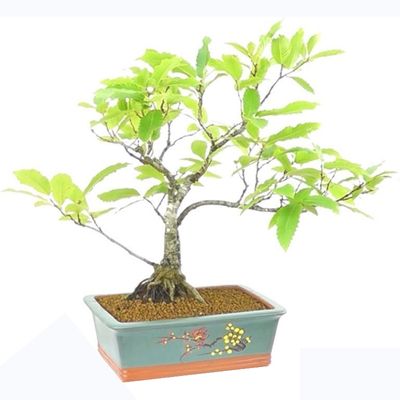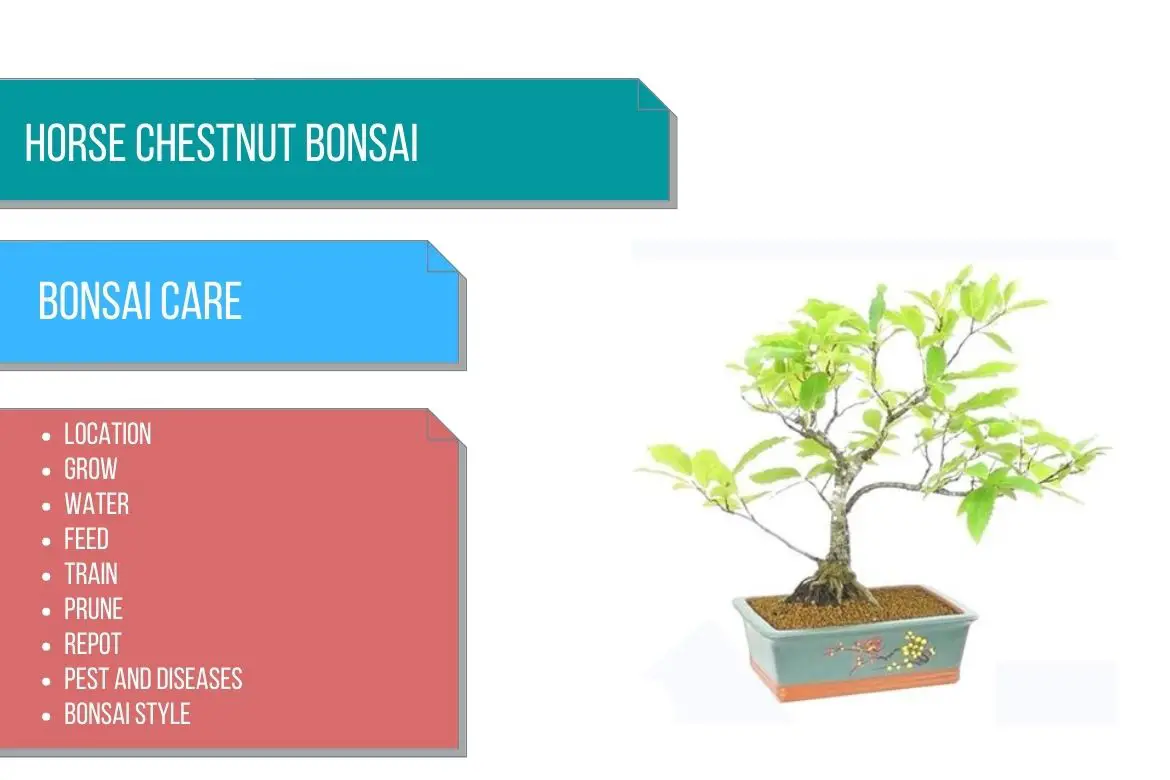
Horse chestnut / Buckeye
(Aesculus hippocastanum)
Country of Origin : South Europe
Bonsai Styles : Upright, informal upright, hollow trunk, group
Zone : 3 – 8
Horse chestnut also known as common horse chestnut or European horse chestnut is a hardy deciduous tree.
Branches and twigs are very thick and stiff in growth habit, and the bark is gray, smooth and characterless.
The leaves of this plant are mid-green and consist of five to seven leaflets.
In late spring and early summer, white flowers bloom in upright clusters. The flowers are followed by mahogany-brown, shiny, conkers. However, this tree is preferred for its leaves and the bark.
Can you bonsai a chestnut tree?
Yes. You can make a chestnut tree bonsai suitable for outdoor bonsai tree. When trained well, horse chestnuts make eye-catching bonsai that are particularly suitable for formal upright, informal upright, and natural tree styles. Among enthusiasts of novelty trees, this species is popular. The only concern some bonsai growers have about this tree is its large leaves. However, these large leaves can be reduced in size with the right pruning technique.
In fact, about 15 varieties of Aesculus spp. are available and several Aesculus cultivars can be used to make a bonsai, including some with double flowers and some with red flowers.
Apart from A. hippocastanum some of the varieties of Aesculus suitable for bonsai are:
- Aesculus indica : Also known as Indian horse chestnut. It has twisted bark. It has white flowers tinged with yellow or pink. The leaves of this variety are smoother and more vibrant than A. hippocastanum. However, care instructions for this variety are the same as A. hippocastanum. It can be growing in zone 7.
- Aesculus cavnea : Also known as Red horse chestnut. It is a hybrid between A. pavia and A. hippocastanum. It has dark pink flowers which are more decorative than A. hippocastanum. However, A. hippocastanum has better foil foliage color.
Read more about other bonsai trees species in : Types of bonsai tree
Best location to keep Horse chestnut Bonsai
Horse chestnut Bonsai is an outdoor bonsai tree however it prefers partial shade.
Keeping it in direct sunlight will scorch its foliage. It is also very tolerant of air pollution.
Aesculus hippocastanum bonsai tree prefer a humid environment and grows well in temperature range of 53-77 °F (12 – 25 ℃).
If the tree is exposed to temperatures above 86 °F (30 ℃), the growth of the tree will be slow.
The tree can tolerate very low temperatures. They need a little bit of winter protection. In case you dont want to worry about winter protection, try A. indica variety. This is a more robust variety of Aesculus spp. (Some chestnut trees growing in the wild can even tolerate brief periods of temperature as low as -40°F but when it is grown in a container, the mileage can vary).
Protect the bonsai tree from cold winds and frost.
IMP: Refer to do bonsai trees need sunlight for more indoor and outdoor bonsai location ideas. Also, refer sunlight requirements for indoor plants for more indoor gardening ideas.
Propagation of Horse chestnut
Horse chestnut germinates from its seeds pretty easily. It can also be propagated by grafting. You can also collect a specimen from the wild.
Watering Horse chestnut Bonsai
Depending on your environment, keep watering the tree regularly in the summer. Don’t be surprised if you find yourself watering the tree twice a day.
Reduce watering in the winter. Keep the soil just moist.
Read watering bonsai tree for more details.
Wiring Horse chestnut Bonsai
Wiring is not that important in shaping Horse chestnut bonsai because most of the shaping is done through pruning. However, if you are still trying to wire the tree, you can do it in mid-summer. This is the time when the twigs have just hardened.
A new horse chestnut shoot becomes stiff and hard to bend with wire after two or three seasons of growth. So do the wiring early.
You can leave the wire on the tree for almost one growing season. You can even remove it in six months if the branch has be put in place permanently.
Read : Detailed guide on How to wire a bonsai
Pruning Horse chestnut Bonsai
When to prune Horse chestnut bonsai?
How to prune Horse chestnut bonsai?
Trunk pruning: Horse chestnut trees have a vigorous growth habit. Hence, the trunk can be quickly tapered by chopping it and letting it grow.
Horse chestnut bonsai trees are a little tricky to prune, because of their terminal bud.
Initially, horse chestnut’s spring growth seems unmanageable, with little or no side-shoot or side-bud growth and unacceptably long new shoots and big leaves emerging from terminal buds.
The reason for this is the dominance of the huge (and sticky) terminal bud, whose hormones stop side-bud development and suppress side-shoot development.
If such bonsai terminal new-shoot growth is left uncorrected, the tree will grow ever taller and wider without any ramification or bonsai form.
1st method: To solve this problem, it is usually recommended to prune off all the long first shoots and to wait for the shorter second shoots to emerge in the same season. You can perhaps leave one or two shorter shoots for wire training.
Keep in mind that this is a slow process and sometimes does not encourage dormant side-buds and small side-shoots to grow.
2nd method: In order to ramify and shape them, buds must be forced to shoot. They will be shorter, angled from the existing branch line, and more numerous.
Perform pre-season dormant-tip bud pruning (in winter). In six to eight weeks, it produces masses of new buds.
Prune unwanted buds from the mass of new buds. Unlike method 1, this method is faster but it will weaken the tree. Hence, only perform this method on a healthy tree. Keep a gap of almost 3 years between repetitions of this method on the same tree. This process will also reduces the size of the leaves.
Maintenance pruning: To keep the shape and silhouette of the bonsai sharp, finger pinch the growing tips of the new shoots. Start pinching when 2-3 leaves on the shoots have formed. You can do this all throughout the growing season.
Now coming to one of the main reasons to prune Horse chestnut bonsai tree i.e. to reduce the size of the leaves. You can achieve this by doing partial or complete defoliation of the tree in early summer. In this way, smaller leaves will be produced.
Read how to prune a bonsai to know about the right technique of pruning and more about defoliating a bonsai tree.
Repotting Horse chestnut Bonsai
When to repot Horse chestnut bonsai?
Horse chestnut bonsai can be repotted every 3-5 years in early spring.
Keep two things in mind however: (i) Repotting this tree often will lead to growth of large leaves. Hence all the efforts you have put into reducing the size of leaves will be put to waste. (ii) Secondly, do not pot this tree in a large pot, as this will also result in large leaves on the tree.
Free-draining slightly acidic to neutral (pH 5.5-7) bonsai soil rich in loam are preferred by these trees.
OR
You can use a mix of sand, loam and peat moss in the ratio 1:2:1.
OR
You can also use a mix of garden compost, sand and fired clay particles in the ratio 2:1:1.
Please check out how to repot a bonsai to know everything about repotting and root pruning a bonsai.
Must Read: Bonsai Soil Recipes
Must read : Choosing the right bonsai container
Feeding Horse chestnut Bonsai
It is important to apply a weak solution of a general liquid feed, as too strong a fertilizer will scorch the leaves.
Spring and early autumn are the best times to feed the tree to encourage new growth, especially in the early and midsummer.
Read more about bonsai fertilizer and its application.
Diseases and pest of Horse chestnut Bonsai
These trees are generally pest free. However sometimes scale insects, canker, coral spot and leaf blotches can be a problem.
For scale insects use systemic insecticides. You can even use Kelthane, Metasystox, or Orthene insecticides. Make sure to follow the directions on the label.
In the case of fungal growth on the leaves and wood, remove infected leaves and parts of the tree. Apply a fungicide. It may be helpful to wash with lime and sulfur in the winter.
I have covered all the bonsai pest and disease identification and treatments in our extensive guide. Please read that to know all the organic and inorganic solutions. Also please read how to keep your bonsai tree pest free for best practices and proactive measure to keep your bonsai healthy.

